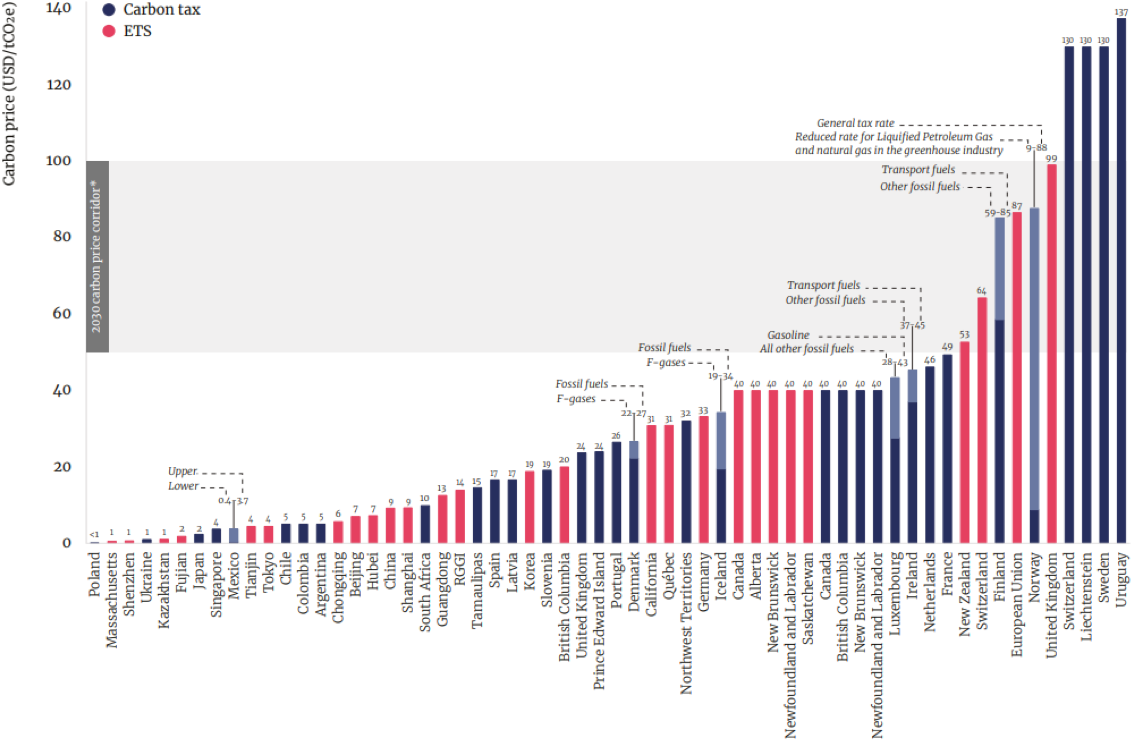Carbon pricing requires companies and other entities to pay for the CO2 they release into the atmosphere. There are two main forms of carbon pricing:
- Carbon taxes; and
- Cap-and-trade programs.
A carbon tax is a charge placed on greenhouse gas pollution, mainly from the burning of fossil fuels. This is implemented by placing a surcharge on carbon-based fuels, such as coal and oil, as well as other industrial processes that result in CO2 being emitted into the atmosphere. The tax is in effect the carbon price. In this instance, the government sets it and generally, the price increases over time.
According to the David Suzuki Foundation, “A carbon tax puts a monetary price on the real costs imposed on our economy, our communities and our planet by greenhouse gas emissions and the global warming they cause. A shift by households, businesses and industry to cleaner technologies increases the demand for energy-efficient products and helps spur innovation and investment in green solutions.”
In other words, a carbon tax makes polluting more expensive and clean energy more affordable following innovation and investment in greens solutions. Sweden has had a carbon tax in place since 1991.
A cap-and-trade program is designed to limit, or cap, the amount of CO2 a company can emit. Those that exceed the limit are required to buy carbon ‘credits’ that are equivalent to CO2 excess emissions. The carbon credits, also known as emissions allowances, are official permits that allow a company to produce a certain amount of carbon emissions. These can be traded if the full allowance is not used, hence the ‘trade’ part of ‘cap-and-trade’.
A cap-and-trade program (also known as an Emissions Trading Scheme or ETS) has the same goal as a carbon tax by changing the costs, incentivising changes in production and consumption patterns toward decarbonisation. By limiting the supply of carbon credits, the government is putting a cap on total emissions. One of the advantages of the cap-and-trade scheme is that the cap on emissions can be sector specific, they can change depending on expected economic growth or environmental targets, and it provides certainty around emission reductions.
Carbon credits are either:
- auctioned by the government and then traded, or
- given free to regulated firms who can then trade them.
These primary and secondary market sales and purchases result in a market price for carbon. In other words, there is a market setting the carbon price.
Since the early 1990s, a cap-and-trade system has been in operation in the US to reduce the emissions of sulphur dioxide and nitrous oxide. In terms of targeting CO2 and greenhouse gases, the European Union implemented a cap-and-trade system in 2005 and today it is the largest cap-and-trade system operating.
Right now, a carbon price covers roughly 20% to 25% of greenhouse gases that the world produces. There are 68 different carbon pricing instruments, being different variations of taxes and cap-and-trade schemes.
Carbon price by country
Source: The World Bank, State of Carbon Trends of Carbon Pricing in 2022. *The 2030 carbon price corridor is based on the recommendations in the report of the High-Level Commission on Carbon Prices. **Several jurisdictions apply different carbon tax rates to different sectors or fuels. In these cases, we have indicated the range of tax rates applied, with the dark blue shading showing the lower rate and the combined dark blue and light blue shading representing the higher rate.
To meet the 2-degree temperature goal of the Paris Agreement, the carbon price needs to be between US$50 to US$100/tCO2e by 2030. Currently only around 4% of global emissions are covered by a carbon price at and above this range.
Therefore, there is a need for higher carbon prices for the world to achieve its Paris Agreement goals.
Some of the cap-and-trade schemes are large, liquid markets. In the four most actively traded carbon markets there were US$689.9 billion worth of futures traded in 2021. This represented a 164% increase from the year before.
The four most actively traded carbon futures markets in the world are:
- European Union Emissions Trading Scheme (EU ETS), which started in 2005;
- Western Climate Initiative (California Cap and Trade Program), which started in 2013;
- Regional Greenhouse Gas Initiative (RGGI covering many North Eastern US states), which was established in 2009; and
- UK Emissions Trading Scheme (UK ETS), which was created in 2021.
Together these markets represent some of the largest regional economies in the world.
VanEck recently announced that, subject to ASX and final regulatory approvals, it would soon offer investors the ability to access the global carbon market opportunity via the VanEck Global Carbon Credits ETF (Synthetic) (ASX: XCO2). XCO2 will track the ICE Global Carbon Futures Index which is an index made up of carbon pricing from the four futures markets noted above.
This is an Australian first and an innovative way for Australian investors to potentially benefit from changes to the price of carbon.
There are short-term drivers that affect the price of carbon, including:
- Changes in current and expected future scarcity of allowances;
- Variations in general economic conditions, eg GDP;
- Revisions to the rules of the systems (including those governing offsets and market stability mechanisms);
- Interactions with other climate and energy policies.
As noted above, over the long-term, there is a requirement for the price of CO2 to rise so that economies around the world are best placed to achieve their Paris Agreement goals.








